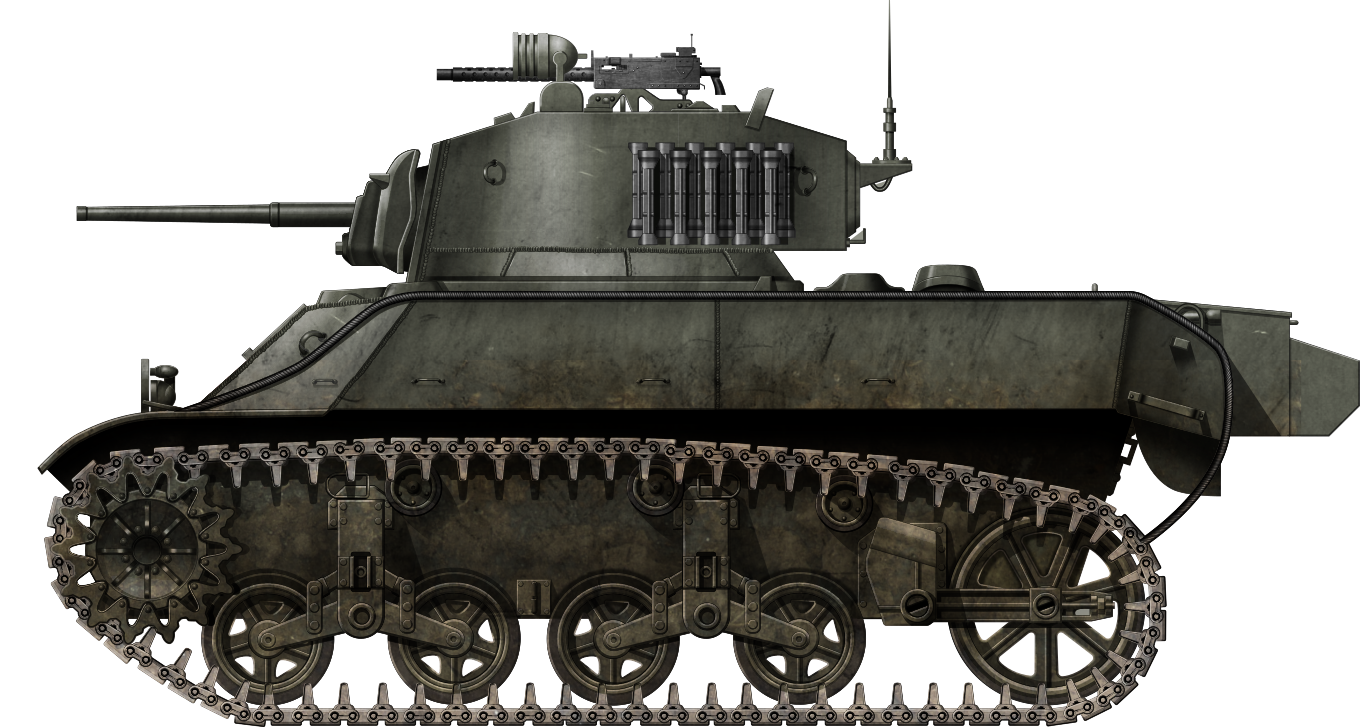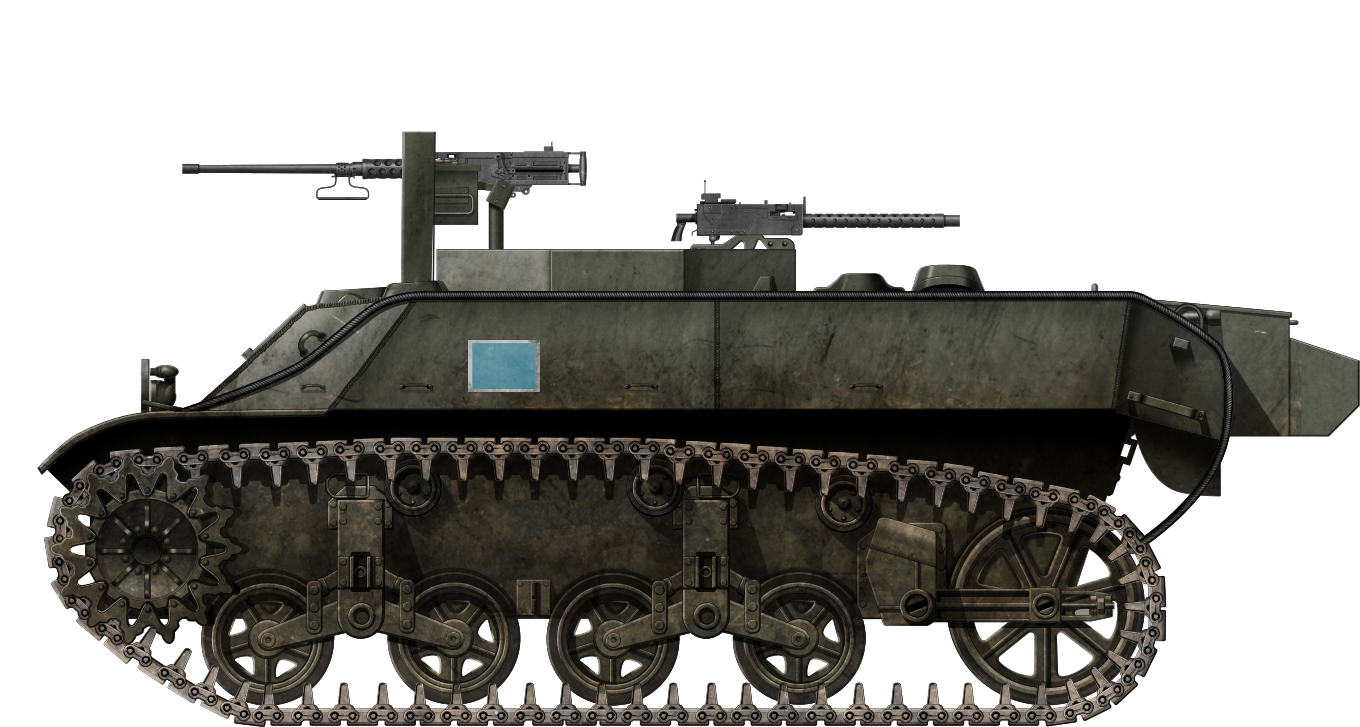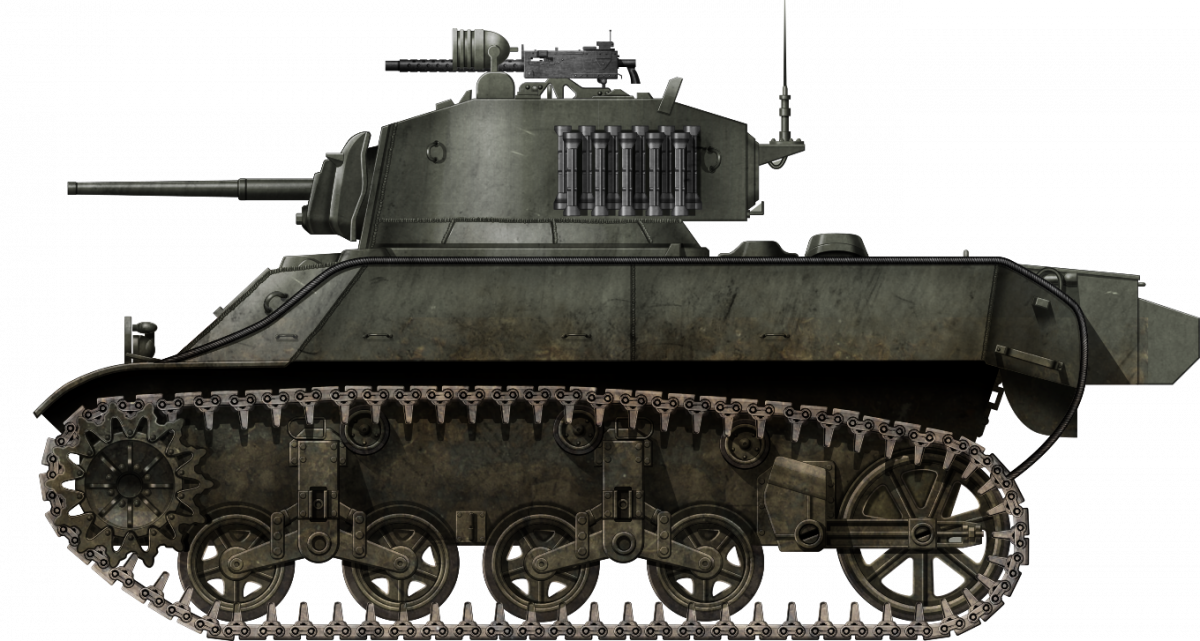 Italian Republic (1949-Mid-1950s)
Italian Republic (1949-Mid-1950s)
Light Tank – Unknown Number Operated
The Light Tank M3, produced by the United States starting in 1941, was delivered to the Esercito Italiano (English: Italian Army) in the late 1940s. The Esercito Italiano, having been reconstituted after the previous Regio Esercito (English: Royal Italian Army) was essentially dissolved during the Second World War, had an immediate need for modern vehicles in the new context of the Cold War. The new army received an unknown but small number of M3A3s, which were used by both mechanized cavalry units and infantry. The Italian designation was Carro Armato Leggero M3A3.

Source: Gli autoveicoli da combattimento dell’esercito italiano
Italy and its Armed Forces after the Second World War
The Kingdom of Italy, later the Italian Republic from 2nd June 1946, emerged from the Second World War as a defeated and devastated nation, stripped of all its colonies and some territories (Istria, the city of Rijeka, and certain areas along the border with France) following the Paris Peace Treaty of 1947.
The Italian army was greatly reduced and temporarily renamed Esercito di Transizione (English: Transitional Army). In 1947, the Esercito Italiano could amass a maximum of 140,000 to 150,000 personnel to maintain public order in a divided country. Italy was plagued by numerous riots, and in Sicily, the issue of brigandage persisted. This was preceded until 1946 by the actions of the Esercito Volontario per l’Indipendenza della Sicilia (English: Volunteer Army for the Independence of Sicily).
However, the Esercito Italiano was by no means prepared to face a potential invasion by communist forces coming from Yugoslavia.
From 1948, due to the dire political situation in Europe, Italian military commands began to approach the United States for the provision of arms and equipment, which were sorely lacking in the Italian armed forces. Through the Mutual Defense Assistance Program, the United States sent aid to the Italian armed forces totaling over $44 million between 1948 and 1949. In the following two years, 1950-51, this figure rose to $360 million. The aid allocated to the Esercito Italiano consisted of light weapons, spare parts, vehicles, and more.

Source: Andrea Viotti e Stefano Ales
History of the Vehicle
With the outbreak of the Second World War in 1939, the US Army became highly invested in tank development. In May 1940, the Americans put the Light Tank M2 into production, which quickly became outdated. Consequently, they developed the new M3, which featured increased armor protection.
From March 1941 to September 1943, a total of 13,859 Light Tank M3s were produced in three versions (M3, M3A1, and M3A3), and these were also supplied to other belligerent countries. By September 1945, the United Kingdom had received 5,473 M3s, the Soviet Union had gotten 1,676, and another 1,926 were distributed to other nations.
The vehicle saw its first combat use on the North African theater of operations with the British Army in the summer of 1942. The British appreciated its ease of use so much that they nicknamed it ‘Honey’. However, it was not highly regarded as a combat vehicle and, by late 1942, its role shifted to reconnaissance duties.
The Light Tank M3 underwent improvements over time and was upgraded with two versions. The A1 version, produced from May 1942, featured an improved turret. The A3 version, produced from September 1942, included hull improvements and a wider turret to accommodate the installation of a radio.
In September 1943, the vehicle ceased production and was replaced by the Light Tank M5. However, it continued to serve until the end of the war and remained operational in many nations even after the conflict.
Service in Esercito Italiano
The first M3A3 tanks, named by the Italians Carri Armati Leggeri M3A3 (English: Light Tanks M3A3), were delivered to the Esercito Italiano in 1949.
The Carri Armati M3A3 were assigned to the Scuola di Cavalleria Blindata (English: Armored Cavalry School), which was established in 1948 starting from the former Scuola di Autoblindismo (English: Armored Cars School). The tanks were allocated to two formations, labeled as ‘A’ and ‘B’, and were utilized by the armored cavalry regiments. These regiments contained a light tank squadron, each equipped with 18 Carri Armati M3A3.

Source: Storia Militare Dossier n. 24
In 1949, the United Nations General Assembly decided to assign Somalia, a former Italian colonial territory administered by the British since 1941, to the Italians as a trust territory to prepare the country for independence. Italian administration lasted from 1950 until 1960, when Somalia gained full independence.
Some Carri Armati M3A3 were assigned to the Corpo di Sicurezza (English: Security Corps) stationed in Somalia from 1949 to 1956, as part of the Amministrazione Fiduciaria Italiana in Somalia (English: Italian Trusteeship Administration in Somalia). A total of 20 Carri Armati M3A3 were sent to equip four tank platoons, each with five Carri Armati M3A3, assigned to the four armored cavalry squadrons deployed in Somalia:
- The 1° Squadrone Blindato ‘Genova’ (English: 1st Armored Squadron) was based in Baidoa
- The 2° Squadrone Blindato ‘Novara’ ( English: 2nd Armored Squadron) in Galcaio
- The 3° Squadrone Blindato ‘Piemonte’ (English: 3rd Armored Squadron) in Belet Uen
- The 4° Squadrone Blindato ‘Gorizia’ ( English: 4th Armored Squadron) in Mogadishu.

Source: rassegnastampamilitare.files.wordpress.com modified by author
On 14th June 1950, two Carri Armati M3A3 from the 3° Squadrone Blindato ‘Piemonte’ were sent to rescue five American passengers from a plane that had crashed around 100 km from Belet Uen.
In 1951, the squadrons were cut down to only two, and, after July 1951, all Carri Armati M3A3 tanks were consolidated into the 1a Compagnia Carristi della Somalia (English: 1st Tank Company of Somalia), consisting of a command platoon and two regular platoons, each with six Carri Armati M3A3. The remaining eight tanks were held in reserve. Since there was no military conflict in Somalia during the Italian trusteeship, these vehicles did not see action.

Source: Vincenzo Meleca
The Italian authorities quickly realized that the Carro Armato M3A3 had become completely outdated. Even as early as an October 1950, a document from the Command of the Brigata Corazzata ‘Ariete’ (English: Armored Brigade) stated that the Carro Armato M3A3 used in the armored cavalry regiments had become obsolete and needed to be replaced with a vehicle armed with at least a 75 mm cannon. By the mid-1950s, all Carri Armati M3A3 had been withdrawn from service and replaced by the M24 Chaffee.

Source: Storia Militare Dossier n. 24
Other Versions
Reconnaissance
The Esercito Italiano also utilized the Carro Armato M3A3 reconnaissance variant. This version lacked a turret and was armed with either a .303 Browning M1919 machine gun or a .50 Browning M2 in a ball mount, protected by a metal shield, along with another .303 machine gun in a casemate.
This reconnaissance version was used by the Esercito Italiano as a reconnaissance vehicle in the reconnaissance platoons of tank battalions, as well as by the cavalry and the Bersaglieri units. It is unclear if these were separate vehicles supplied by Italy’s allies, or if these were converted from the previously received M3A3 light tanks that had been withdrawn.
This variant had a fairly long service life, and only in the late 1950s was it replaced as a reconnaissance vehicle in tank battalions by the M24 Chaffee. In 1963, a decision was made to repurpose them as radio vehicles.

Source: Gli autoveicoli da combattimento dell’esercito italiano
Conclusion
The Carro Armato Leggero M3A3 was certainly already obsolete by the late 1940s and was primarily used as a stopgap by the Esercito Italiano in anticipation of its replacement with a more modern and suitable vehicle.
Its main actual use was in Somalia, where it performed decently, but for the most part, it had become ineffective in other contexts.


Carro Armato Leggero M3A3 specifications |
|
|---|---|
| Dimensions (L-W-H) | 5 x 2.53 x 2.5 m |
| Total weight | 14.2 tons |
| Crew | 4 |
| Propulsion | Continental 7 cylinder petrol 238 hp – air cooled |
| Max Speed on road | 50 km/h |
| Max Range | 192 km |
| Armament | 37 mm M6 3 x .30 M1919 machine guns |
| Armor | From 13 to 38 mm |
Sources
R.P. Hunnicutt Stuart. A history of American light tank. Volume I Novato 1992
http://www.corazzati.it/scheda_m3.htm
Steven J. Zaloga M3 and M5 Stuart Light Tank 1940-1945 Oxford 1999
Nicola Pignato and Filippo Cappellano Gli autoveicoli da combattimento dell’Esercito Italiano. Volume terzo (1945-1955) Roma 2007
Andrea Viotti Struttura, uniformi e distintivi dell’Esercito Italiano 1947 – 1970. Tomo I Roma 2007
Vincenzo Meleca Il Corpo di Sicurezza della Somalia
Filippo Cappellano, Fabrizio Esposito and Daniele Guglielmi Storia Militare Dossier n. 24 ‘Mezzi corazzati e blindati dell’Esercito Italiano 1945-2012. 1a Parte’ Parma 2016
Leopoldo Nuti L’Esercito Italiano nel secondo dopo guerra 1945-1950 Roma 1989
Lorenzo Sebesta I programmi di aiuto militare nella politica americana per l’Europa. L’esperienza italiana 1948-1952 in ‘Italia Contemporanea’ n. 173, December 1988


2 replies on “Carro Armato Leggero M3A3 (M3A3 Light Tank in Italian Service)”
Did the Italians capture any examples of the Stuart during the war?
Yes, at least one that was sent to Rome for evaluation.